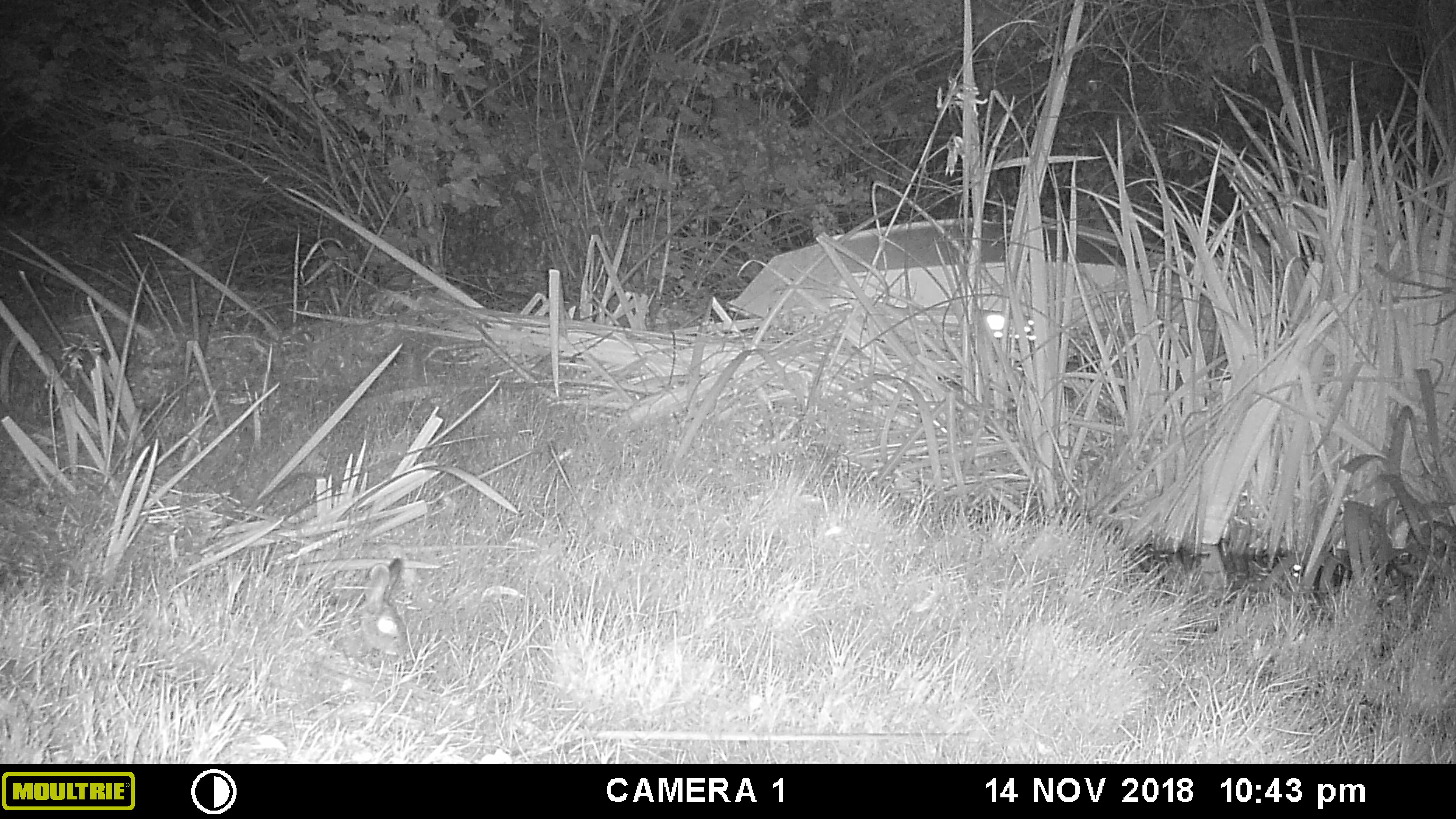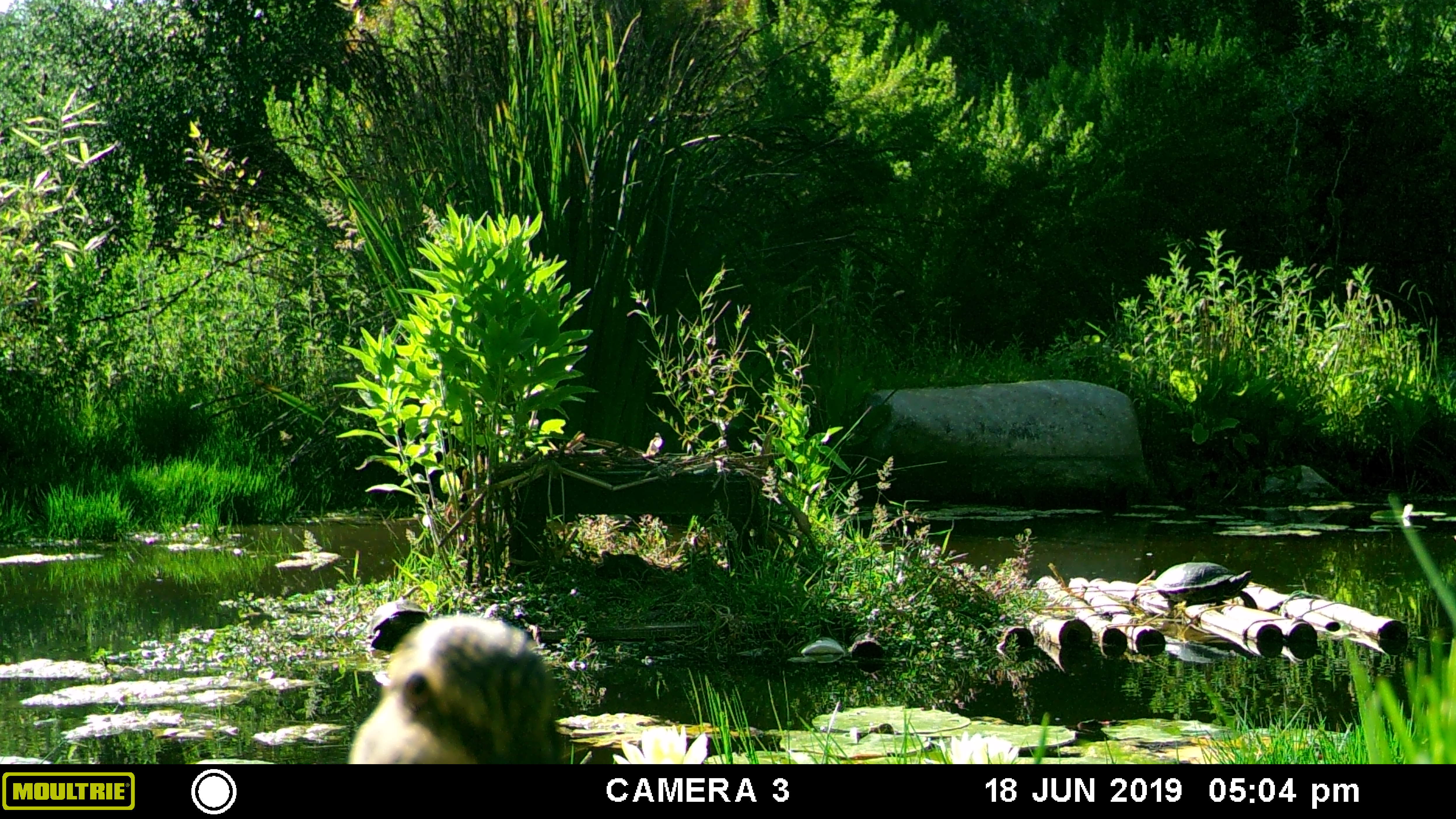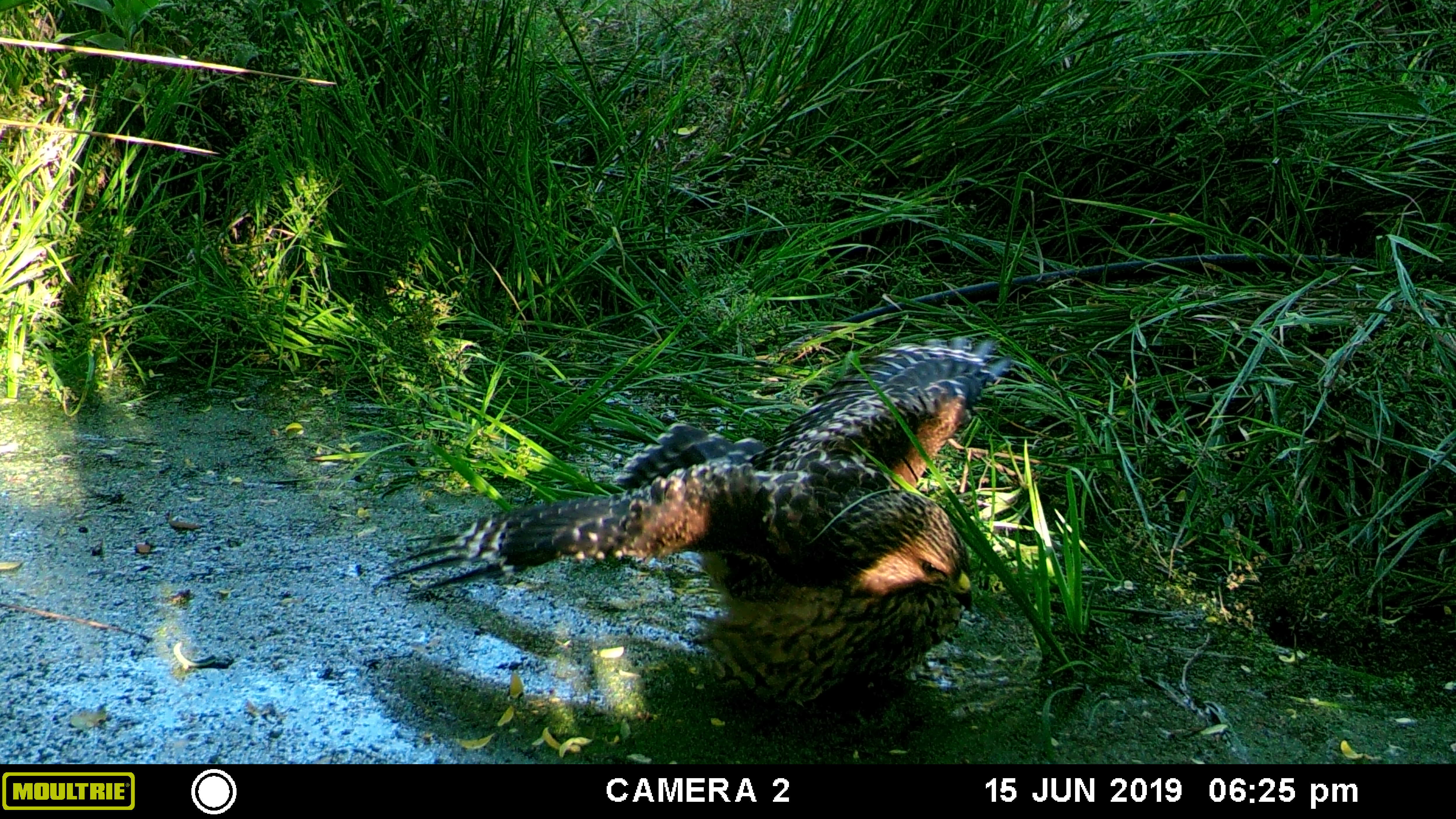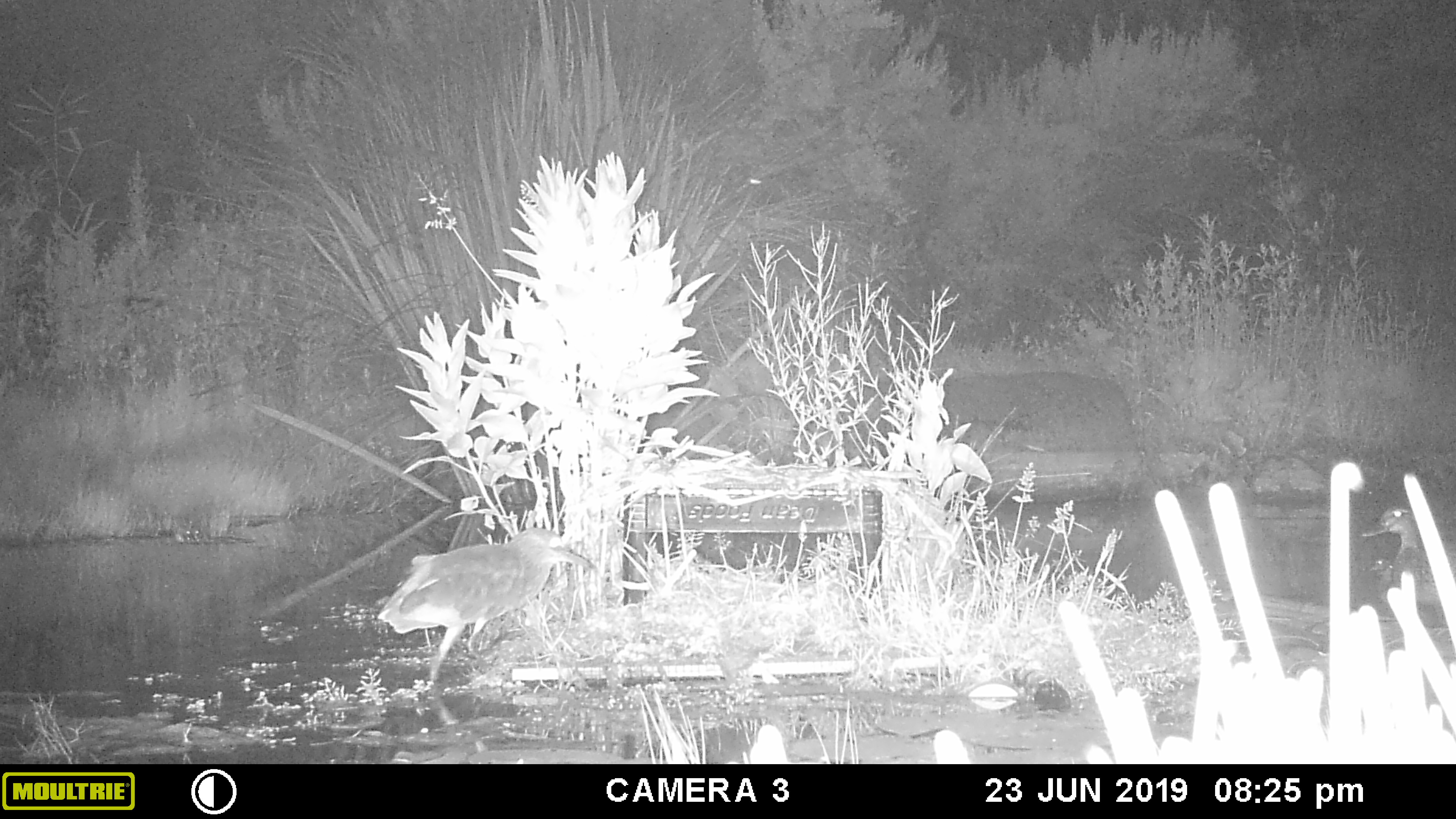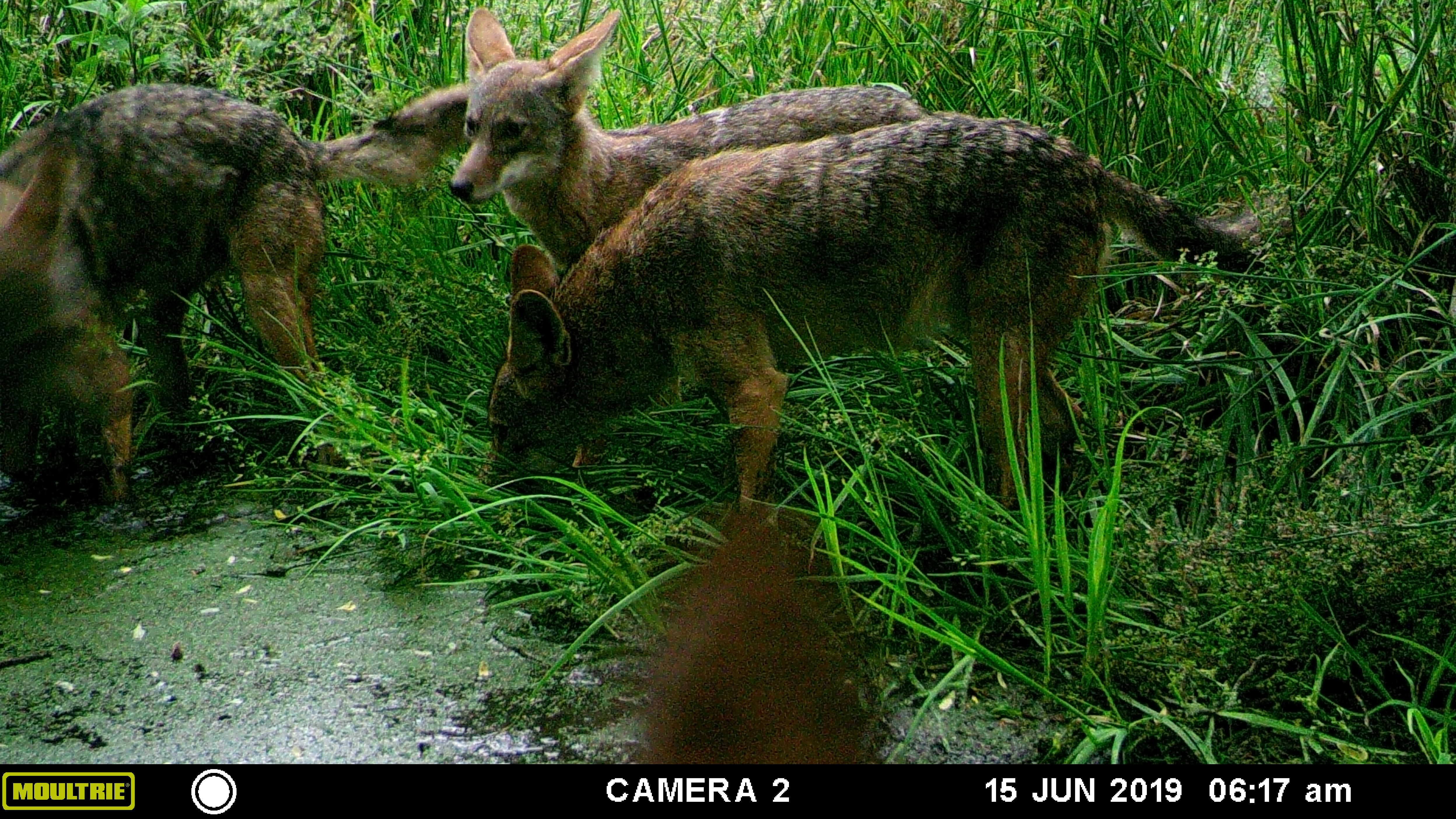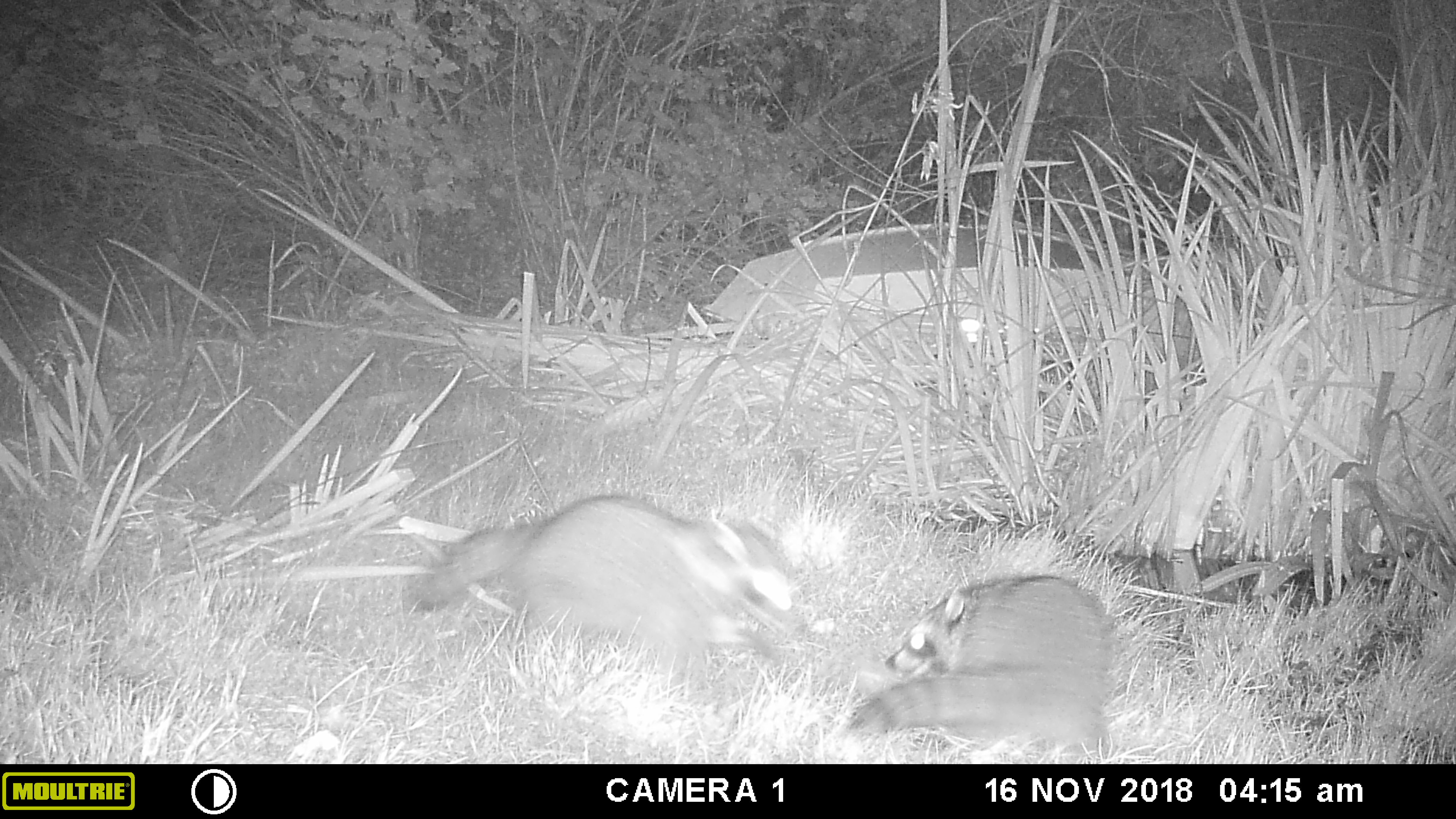Permaculture and Edible Forest Gardening Adventures
I am turning my acre + watershed filled with junk palm trees into an edible forest garden, using permaculture and recycled materials. The journey begins Feb. 1, 2011.
-
Owl in Good Time
Delightfully, the streambed wildlife camera has also been picking up an adorable owl visitor these last couple of months. Western Screech Owls (Megascops kennicottii) are certainly present in the area, but much less common to see than Barns and Great Horneds — they’re more reclusive than those much larger species, hunting mostly different prey and small enough to be at risk from larger raptors themselves. The ones on our property have made themselves known by the distinctive “po-po”, ping-pong-ball-bouncing call that only ever rises up from the tangle of trees in the streambed. We’ve only seen one in person on the property once, when a tour stop under the Big Oak above the stream woke it from its chance nap inside the disheveled old owl box dangling from a branch.
But we seem to have at least one — apparently very dirty — screech owl hanging around this summer, taking baths at the camera point at least a couple times a week. And it’s just the cutest darn thing.
“I meant to do that.” A very imperfect ablutioner. Here in lower elevation areas of Southern California, screeches stick near waterways because those habitats are where we have large trees; as cavity nesters that have adapted to have cryptic coloration and patterning that allows them to blend in with bark, large trees are essential. Happily, we have some big trees extant and growing in our little slot of land. And we have a number of conservation organizations locally who are working to preserve wild land and especially land connected to waterways, as these are always areas of higher species density and diversity. And they say that Western Screech Owls readily use owl boxes made to their dimensions. Wish list!
Bath interrupted by a sphinx moth. Crane flies also make cameos. -
Kit for Kat
Lots has been happening on the wildlife cameras recently. We still have camera 1 in its original spot, overlooking the north bog on the big pond, but we’ve been playing around with the positioning of camera 3 in the streambed and shifted camera 2 to the top of the stairs that lead under the Big Oak and down to the streambed where camera 3 is. Let me tell you, this has been a very rewarding set of adjustments!
We have to start our series of catch-ups, though, with the charismatic megafauna, and our most unusual visitors. They’re not regionally unusual; it’s simply our more urban, road-locked setting that makes them unusual on-site. Luckily, the little unnamed seasonal waterway that links numerous properties in a little strip transecting East Alvarado seems to be a relatively unrestricted roadway for many species. Healthy, natural waterways are important in so many ways!
Back in March, we shared our first ever sighting of a bobcat on our property with you. Well, we were absolutely staggered and thrilled when we pulled these videos off the cams recently:Surprise! Looking back at our first bobcat sighting video, it’s actually pretty obvious that cat was carrying a little extra weight — wonder where she denned! Bizarre reflection effect in this video that hasn’t happened in any other video. Ghostcat! (Steals mah hawt.) If those didn’t play for you, do visit our YouTube channel to check them out!
We’re very excited by the cutie kitties, although we’re taking extra care with the door of the Fowl Fortress!
-
August at Finch Frolic

Black Beauty zucchini. This year Finch Frolic has been particularly beautiful. Of course, this year we had to close down throughout the spring. Fortunately we’ve been able to reopen for limited-capacity tours with safeties in place. However, I really miss sharing how lovely the garden is, and I want to let you have a little tour right in your home.

Little Marvel Popcorn. It tastes so good! These photos were taken this morning before the temperature rose; its in the 90’sF here today, in North San Diego County. I apologize for the phone camera, as my good camera is in for repair. I only wish that you could also smell the moist mulch from the light overnight dew, or hear the clug-clug of the crow, the tittering of a flock of bushtits and the scuttling of lizards through leaves, which I experienced as I walked around the garden. All of these friends and so many hundreds more are working the garden today and every day, keeping it in balance.

A blue dasher dragonfly, one of many species that patrol for insects all over our property. Their larvae in our ponds look like little dragons, and they eat mosquito larvae as well. Watercress behind. Our food forest is a low-water-use garden, on poor soil, using no additives to the ground other than occasional compost. There are no herbicides, pesticides or other factory-made chemicals used here, and there are two of us who care for the garden. Most of the seasonal beauty this year is due to the diligence of my daughter Miranda who took seed sprouting to a whole new level even before the pandemic arrived. We rely heavily on the insects, birds, lizards, frogs, soil and water microbes and creatures to do all the work protecting the plants, and the plants themselves to create good soil. All we add is a low dose of salty well water which the humus cleans, and leaves or sheet mulch on top. Our fruit trees receive a dose of blender compost once in awhile. Miranda and I hope that these photos bring you peace and lift your spirits, and that knowing you are looking at a safe habitat that is thriving with life gives you a feeling of security as well. It can be done. Permaculture must be done. Best of health! Diane

From the driveway looking down the main pathway into the garden. 
Lorenziana Gaillardia, to feed the pollinators. 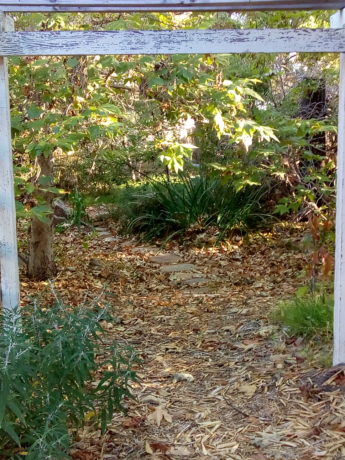
Rock steps cross the large rain catchment basin. Sycamore leaves protect the soil from the heat. 
Our new orchard, with beans trained up a teepee over a fruit tree, and tomato cages behind. 
Our old Ca. Live Oak. Oaks are home to over 300 species of bird and insect. 
Our jasmine-covered gate in the sun. 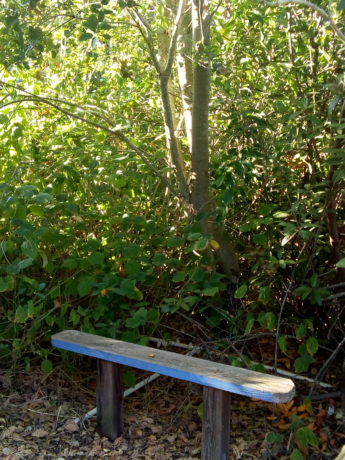
Resting place, made from recycled wood. 
Figs! Panache Striped Tiger. 
Dawn through the birch trees, with Naked Lady amaryllis blooming behind the blackberries. 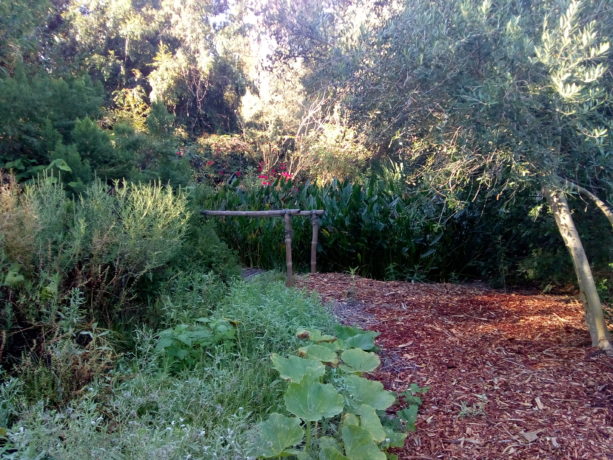
Our small bamboo bridge next to our little pond. 
Dawn through an olive tree. 
A native mallow wildly blooming over a bamboo footbridge Miranda just built. 
Black Krim. 
A plant guild combines plants with different functions for the benefit of all. 
The Torch Tithonia is over 5′ tall, and butterflies and birds love it. A plum, squash and orange tree in the foreground. 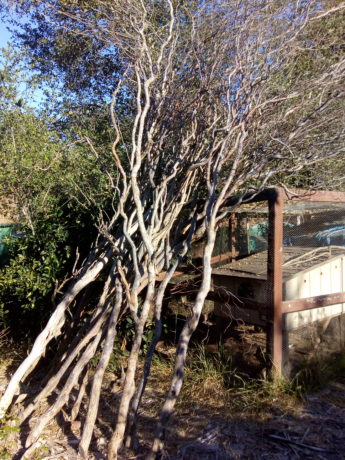
We pollarded our willow trellis in January, and these tall interesting limbs are waiting for some creative project to arise. 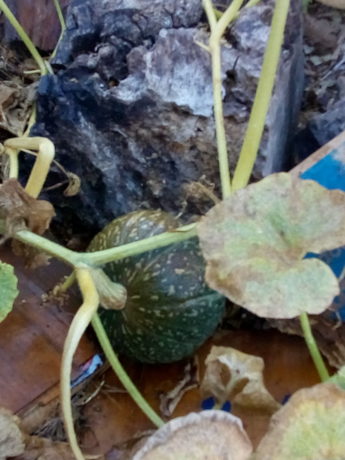
Kabocha squash. 
An army worm taking a sleep in a mallow flower. 
We grow the timber bamboo, and eat it, too! 
This beauty is a carrot, Lunar White, allowed to go to seed. Gorgeous and great food for our tiny native insects. 
Lorenziana Gaillardia. 
Straw flower and carrot. 
Apples do very well in hot weather. Cripps Two. 
Red Kuri squash vine past the seating. 
A whole mess of Naked Ladies! 
Tall Double Mix strawflowers, (Helichrysum bracteatum). 
The Withy Hide, or willow hut. 
Hard to believe that these massive trees grew so quickly. It has everything to do with water capture in the soil. 
This stump has personality! Brachychiton rupestris, Australian Bottle Tree. 
The leaf cover makes this rain catchment basin look full. 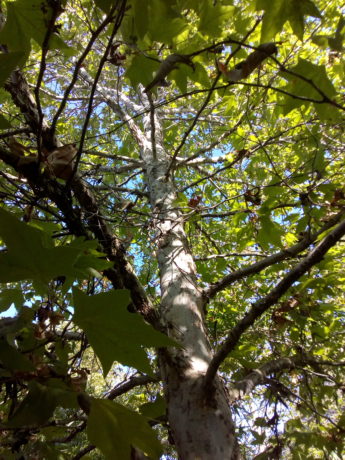
California sycamore, 8 years old. 
A covered bridge over the rain catchment system. 
-
What Food To Plant

At this time we are in month #2 of the Corona-19 virus quarantine. Many people are concerned about food shortages, and purity of what food they are eating. Suddenly the availability and the sheer cost of buying ‘organic’ food is not looking so sustainable. But what can you plant?
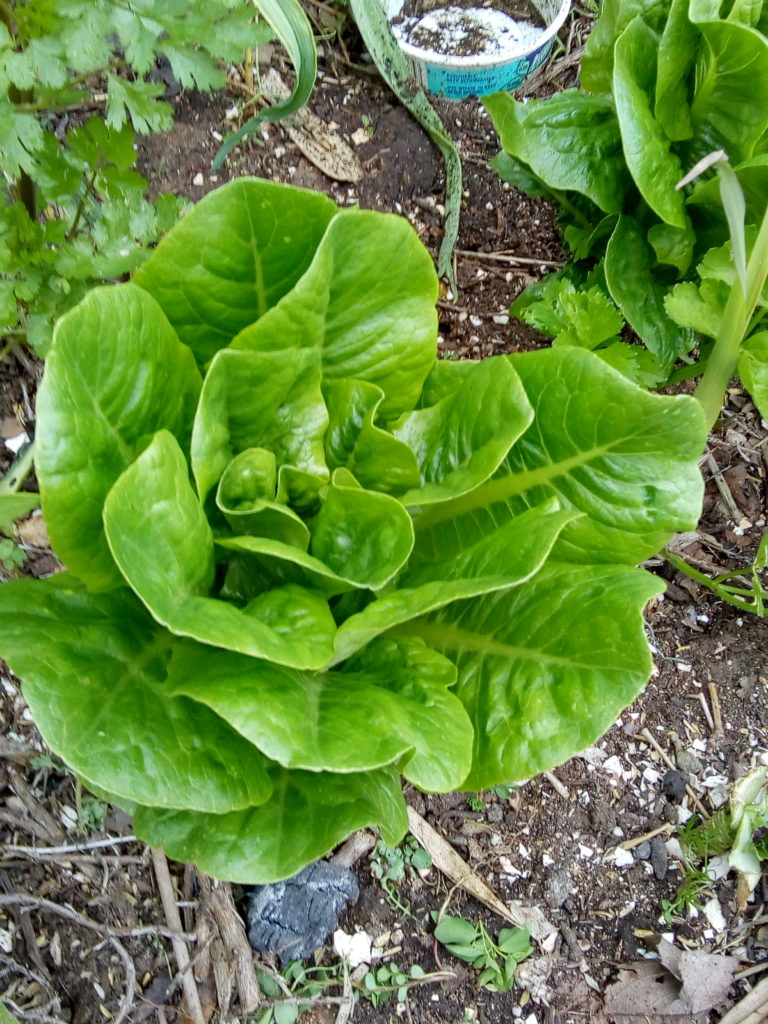
First of all, if you have an organic CSA (Community Supported Agriculture) or food stand near you, or farmer’s market with organic food, please buy from them as much and for as long as you can.
If you want to grow food, the here are some tips:

Zucchini, garlic, bush beans and cilantro allowed to go to bloom. Plant what you want to eat. That may sound simplistic, but if you don’t eat yellow summer squash, then don’t plant it. If you really don’t like kale but think that you should eat it, you may want to use the space for something you will eat. If you are thinking of perennial foods such as fruit trees, evaluate your space and also what fruit you really want to grow. Some things are just better off purchased from a farmer than given the space and water in your yard. If you use limes once a week, growing a big thorny lime tree in a small backyard doesn’t seem practical, but if you have half an acre its fine. See what its growing requirements are and if you have enough heat or chill factor or water to grow that specific tree.

Beans growing up stick teepees around a young plum tree. Plant enough for your family to eat. One or two strawberry plants aren’t going to give you the crop that you want, or will one been plant. If space is limited, then decide what you want to grow a lot of, and limit what you are growing per season to those crops.
What season is it? Don’t be fooled by what plants are for sale in box stores, hardware stores, and even nurseries which should know better. You can’t grow corn planted in the Fall: there isn’t enough day length or warmth for them to mature. Depending upon where you live, there are windows of opportunity for planting, down to here in the valleys of Southern California where you can plant something all months of the year. Which is pretty exhausting, actually.

Fresh beans come in ‘bush’ or ‘pole’ size. Pick what fits for you. Plant food that not only can be eaten fresh, but also those which can be dried, frozen, canned or otherwise saved for off-season. Its great to eat fresh salads, but plan for protein and flour sources as well. Grow pinto, black or other ‘dry’ beans, those which you leave on the plant until the pods dry and then you harvest and keep the beans. There are so many beautiful beans, with so many different textures and flavors! And they have great names, like Christmas Beans, Goat’s Eye Beans, etc. As most of these are tall-growing, you can put these beans on poles or other vertical supports and save room in your garden. Remember that legumes are nitrogen fixers, so don’t pull up the plant, cut it at its base to leave the roots and their nodules to feed the next crop.

Assortment of edible pumpkins and squashes on their way to the Food Pantry Don’t forget about pumpkins and other ‘winter’ squash. Kabocha is a Japanese winter squash that is delicious, not too ‘squashy’, and keeps its shape when in tempura or in a soup or stew. Delicata is mild and delicious. Spaghetti squash has a mild flavor and is fun to eat, but usually needs some pizza treatment to make it interesting. There are a lot of winter squashes with a myriad of flavors, sizes and textures. Pumpkins and other winter squash can keep for a month or more, depending upon their variety. If you have large ones, prepare to have to ‘butcher’, prepare, use and store a lot of food. Pumpkin pancakes, bread, soups, stews, baked pumpkin, pumpkin chai…. mmmm.
Yes, you heard me right when I said flour. Growing wheat is possible, but growing enough to make a difference, then separating the chaff and grinding it finely enough to use for flour is quite the endeavor. However, you can easily grow corn and make cornmeal. Hard corn is the same as those pretty ears you see at Thanksgiving. You allow the corn to dry on the stalk, and then separate the kernels from the ears (shucking), and store them as is, or put them in a high speed blender and grind them finely. You may need to sieve the results a few times and repeat to get a fine flour, or even use a mortar and pestle for some stubborn bits, but the flour is excellent and can be refrigerated or frozen.
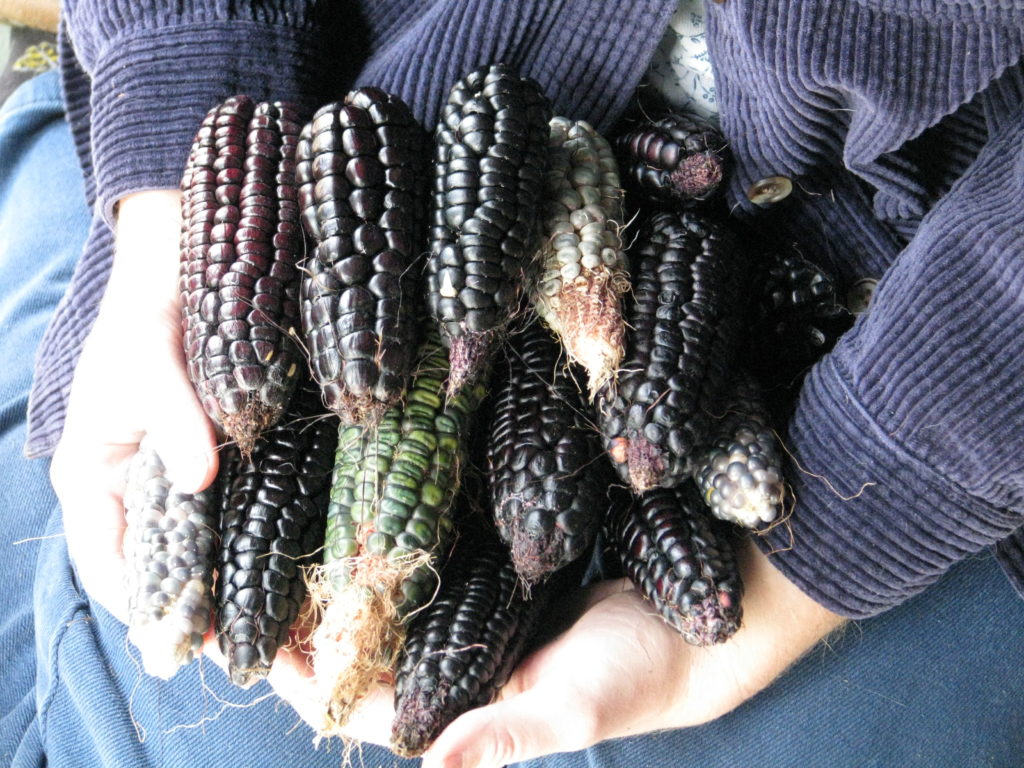
Colored corn makes colored corn meal, too. We’ve grown Black Corn and had dark purple corn bread, absolutely love blue corn meal pancakes, and this year are growing both Hopi green dent and red corn. Can’t wait for green cornmeal for Halloween!
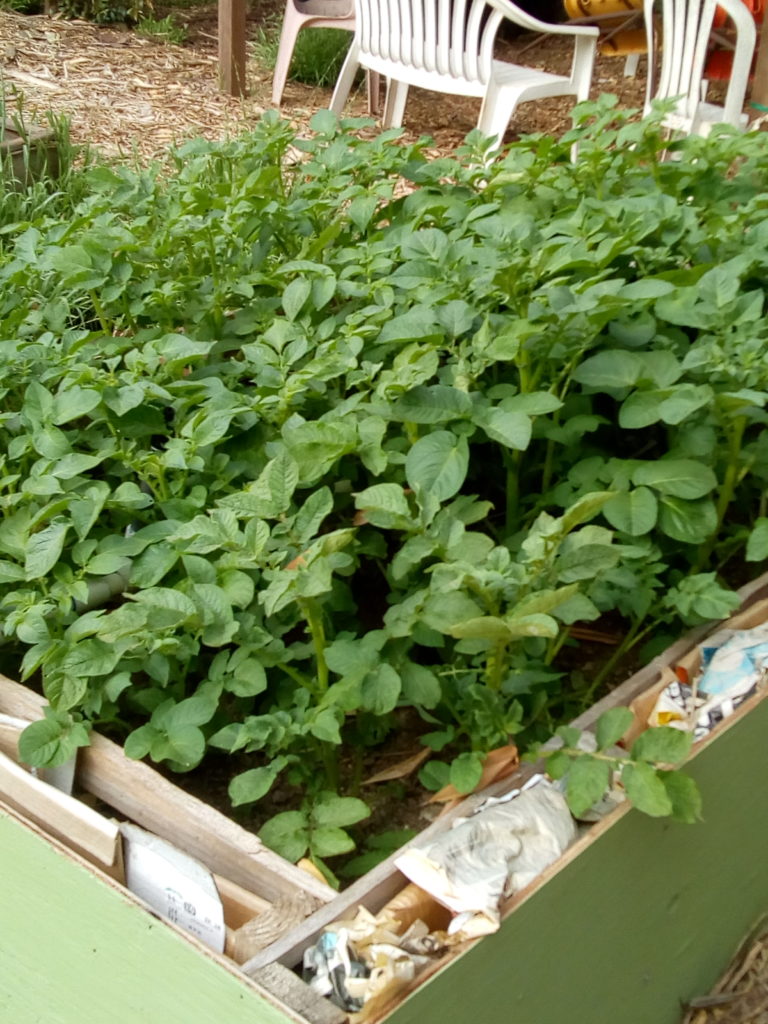
‘Irish’ potatoes grown in a cardboard-insulated pallet bed. Its filled as the plants grow. Don’t forget about tubers, either. ‘Irish’ potatoes, which don’t come from Ireland, grow from swollen stems and can be planted in containers and then hilled up around the growing stems. More potatoes will grow from the side stems. You can plant ‘trash can’ potatoes, or have a bed especially for them. These potatoes don’t mind some cold. There are white, yellow, red, blue, purple, red-skinned, purple-skinned… so many different potatoes with slightly different textures and flavors. I love the purple-inside variety; it makes great colorful mash!
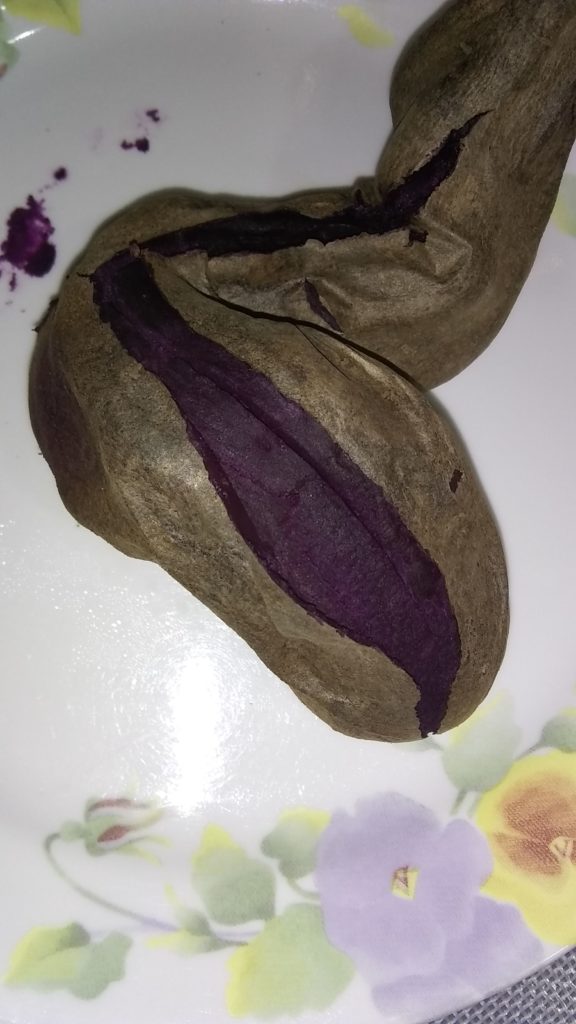
Purple sweet potatoes are AWESOME! Sweet potatoes and yams, which are basically the same thing, are a tropical plant best put in the ground when the soil and temperatures warm up. If you are iffy about eating sweet potatoes… grow your own and taste them without all that marshmallow gloop all over them. They are absolutely amazing. And their leaves are edible as well (not so with the ‘Irish’ type!! Those are related to tomatoes). There are colorful varieties of sweet potatoes as well, and they can certainly be grown in the house as a lovely house plant under the right conditions, and then dumped and eaten!
Don’t forget about growing herbs, not only that you can eat fresh such as basil, but those you can dry such as oregano and dill. Don’t forget medicinal herbs that you can make into tea whether fresh or dried, such as chamomile, catnip (it works as a pick-me-up for humans!), mint (anti-depressant and stomach soother), rosemary, and more. Perennial herbs can go anywhere in your landscape; annual herbs can have their own bed or be tucked in between your veggies as companion plants. Allow some herbs to go to flower to attract the tiny beneficial insects.

Cilantro going to seed. Excellent flowers for tiny beneficial insects, and seed for next season. If you suspect that your soil may be contaminated from a former agricultural or industrial business, such as a paint factory, that was on the land before your home was built, please have your soil tested for lead, chromium and arsenic at the very least.
Growing your own food is very rewarding, and well worth the work. Protect your food from hungry animals with wire, over and if necessary, under. Make sure the plants have regular water, so hooking up a watering system on a battery timer is a smart move for busy people. Place your veggies close to the house so you will run out and harvest when you want something. Make sure your site has enough sun even in the winter so that, if weather in your area permits, you can grow outside then as well.
Don’t forget that all of those veggie scraps can be saved and then used to make a really amazing broth before they are finally composted. The broth can be frozen.
Have fun with your veggies! Stay healthy! Best wishes to all of you from Miranda and me.
-
Aphid Predators II
A WALK ON THE TINY SIDE

Remember this image of a sneaky syrphid fly larvae? Well, what I didn’t point out before was that there’s an even sneakier attendee at this aphid-nomming party. And she’s that little black line across the white leaf vein in the top middle of the photo: a parasitoid wasp.
Parasitoid wasps are pretty full-on — their simple life functions can include grotesqueries you thought only originated in the imaginations of sci-fi script writers. But they’re part of the complex web of ecological checks and balances in their systems.
The difference between parasitic and parasitoid is that a parasitic animal generally doesn’t kill or even directly seriously harm the host; it needs the host to continue functioning so that it can support the parasite. A parasitoid uses the host up in the process of supporting its own growth and/or reproduction.
That sneaky parasitoid lady and her cohort are the authors of the scene of destruction above. What look like little brown bumps on my Brussels sprouts leaf are in fact the corpses of aphids: the dried, hardened exoskeletons of used-up hosts. You can even see a small, round hole in the top of one — the door the exiting parasitoid punched out and left open behind it.
Parasitoid wasps like this one home in on the distinct chemicals released by the feeding and typical drama (like terror over a syrphid fly larva attack) of an aphid colony. Fertilized females settle on leaves and begin their prowl.
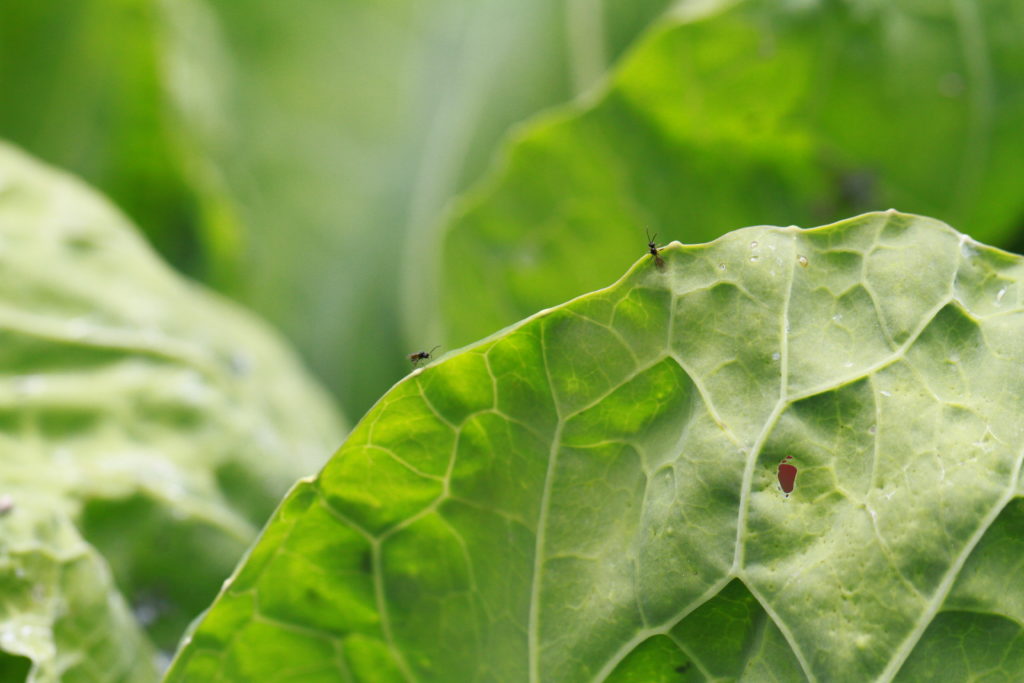
They’re looking for nice, juicy aphids that will be able to feed their grubs to adulthood. With a quick stab of her ovipositor, a female wasp injects a single egg into a chosen aphid, then prowls on. Once that tiny egg hatches, however, the aphid will slowly be hollowed out from the inside by the hungry, growing grub, until only a husk is left and the mature wasp breaks its way out, exercising its brand-new wings in flight for the first time.
The world is made up of opportunities being taken: everything is a resource and every resource is a chance for an existence to bloom. Sometimes, that existence is just really horrific. But it works for them and it works to create a functioning ecosystem — dynamic equilibrium — so we can all actually be very grateful for the parasitoid wasps.
Creeped out, but grateful. -
Aphid Predators
A WALK ON THE TINY SIDE
Another blooming colony of cabbage aphids (Brevicoryne brassicae) on my brave Brussels sprouts: a familiar sight, especially as the weather warms.
But wait — what’s that?
That! The green thing!

It may look a lot like a cabbage white butterfly (Pieris rapae) caterpillar, but it’s definitely not. Take a closer look and you’ll see that rather than a mouthful of sprout leaf, this little green guy is munching on aphid.
One of the most numerous, in terms of species, groups of animals on Earth are the flies, order Diptera. Like any large family, there are some gems, some bad apples, some neutrals — and of course, all that depends on your point of view. To aphids, larvae of some Syrphid flies (family Syrphidae) are stone cold bad-‘uns.
Also known as ‘flower flies’ and ‘hover flies’, these natty little fellows pull a lot of weight (each species in its own way) in both natural and altered ecosystems. Their secret is in their adaptable nature: they’re able to take to human-made environments, so are often some of the only native wildlife in housing developments.

The tellingly-named four–spotted aphid fly, Dioprosopa clavata. Most species in North America as adults mimic bees with yellow, black and striped uniforms and certainly rival and even surpass native bees in pollination services (bees are generally more sensitive in many ways and so are more often excluded or eliminated from habitats). They eat nectar and pollen, as bees do, thus the common name ‘flower fly’.

Flies’ eyes are very distinctive and always give away dipterid mimics passing as other insects — you can’t hide those flyin’ eyes, Copestylum avidum! And of course, most syrphid fly larvae are voracious predators of aphids, making them powerful elements of any garden’s pest management system (a.k.a. ecosystem). Be sure to make friends with yours! Get in touch with Pest Control Cincinnati

-
This Article is a Stubbin
We took a rare day completely off work last Thursday and had a rainy day in. I say “off work” — we did get some tasks done, but they’re fun tasks that get pushed back by more serious jobs. Seed shopping (!!!) and checking our wildlife camera SD cards.

Hey — who’s in those peas?! Oh, it’s me. The wildlife camera on the wild streambed at the bottom of the property is set to take 15 second videos. Going through these can be a bit of a chore — maybe several hundred to over a thousand a month, and so many are just waving leaves or half a second of raccoon tail going out of shot at the start and fourteen and a half seconds of mud and leaves. Or rats. Lots of thirsty rats.
[Edited down from 15 seconds for your viewing convenience.]
https://youtu.be/MW6rp6LP1KQThe site the camera’s positioned at is an intersection with a runoff vein from another property, so it’s a real bird hotspot, and the streambed acts as a road for larger mammals. Wading through the dreck can really pay off — that’s why we have the camera down there still.
Imagine our startled shrieks of delight when we clicked off another “wind” video and encountered this big, stubby payoff:
It’s not every day you get to add another mammal to your property species list! Come eat our rats, Mr/Ms Bobcat!
-
A Video Journey Through Finch Frolic Garden with Kaye Kittrell
We were visited in early November, 2019, by Kaye of Late Bloomer video blog fame. Come have a short virtual tour of our permaculture food forest in the Fall. Please visit Kaye’s YouTube channel, Kaye Kittrell | Late Bloomer Urban Organic Garden Show , to see more of her adventures in gardening. Also, please ‘like’ the video to show Facebook that you care! Thanks for watching.
- Gardening adventures, Heirloom Plants, Permaculture and Edible Forest Gardening Adventures, Planting, Recycling and Repurposing, Seeds, Soil, Varmints, Vegetables
Corn Stalks as Pea Stakes

Our corn grew to a ginormous 10′ height this year in our raised pallet beds. The roots of corn are very sturdy; we usually cut the stalks above the roots, and allow the roots to stay in the ground to decompose. Often they are there a year later, still holding the soil.

Miranda being consumed by corn and zucchini. As it is October and, despite the 95 degree F. temperatures and hot, dry Santa Ana winds that are so typical of Fall here in Southern California, it is time to plant winter crops. Peas are the top of the list to plant. There are many types of peas. Some are valued to be eaten as pods when the peas inside haven’t matured. Some – and these are my favorite – produce juicy round peas that can be shelled and frozen for use all year. Some produce a lot of tendrils, and these along with the new leaves and shoots are eaten in salads and stir-fries, and are very attractive. There are also cowpeas, which are really beans that enjoy warmer weather, so not a candidate for winter crops. Best of all, peas and the rest of the legume family set nitrogen in the soil. They have a symbiotic relations ship with certain bacteria that must live in your soil for this to happen. The plant harvests nitrogen out of the atmosphere, and stores it in nodules on its roots. When the roots die, either from the plant being cut back or dying, the nitrogen is released into the soil in a plant-usable form. No need for chemical nitrogen fertilizers.

King Tut peas are good eating before and after the peas form in the pods. The peas are green. 
King Tut flowers are gorgeous. One of the problems I’ve had growing the tall peas is having the best supports for them, especially in raised beds. I never seem to have tall enough posts, or the posts fall over and chaos ensues. This year we decided that we’d already grown our pea supports: our corn.
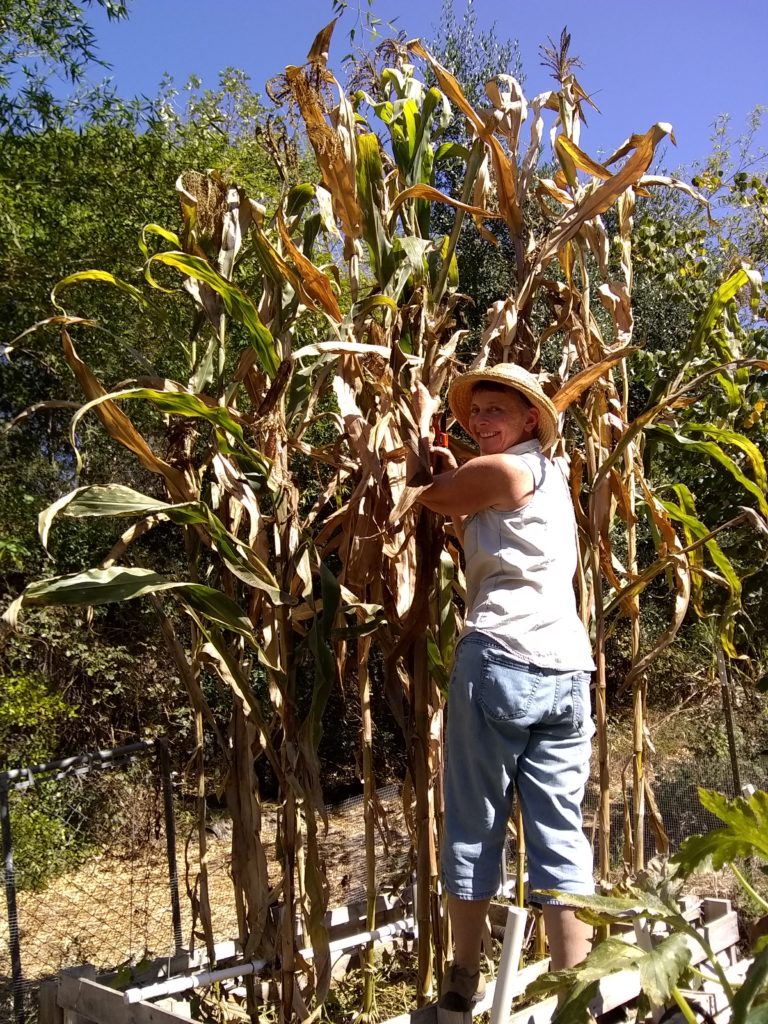
Trimming a few feet off the corn. I’m 5’3″ tall, for comparison. I have a phone in my back pocket and my pants are loose, so please don’t think I’m that saggy! We cut the corn stalks down to about 8 feet; above that the stalk was a little weak, and the stalks would be tall enough for our purposes. Then we planted vining (not bush) peas in and around the base of the corn. We had a lot of success with King Tut peas last year, which had beautiful purple pods (but green peas), so we opted for more of these in this bed.

Miranda planting around the corn. We left some of the cut sweet potato vines we’d just harvested from this bed to help hide and protect the pea seeds, and to return nutrition back into the soil. Now the peas are growing rapidly, and we’ll be able to train them up the sturdy, straight corn stalks with the help of some twine. When the peas are done, we can either use the stalks all over again for another climber, depending upon how they last over winter, or we cut the corn and the pea plants at the surface of the soil and put the whole pile into a compost pile, or into another raised bed. Corn is a hungry plant, so the pea’s nitrogen-fixing capability will help restore fertility to that raised bed. Remember that we use no fertilizer other than in-bed composting using kitchen scraps, plant cuttings, manure from our hens, and leaves, and anything else that will decompose. The beds are being watered by salty well water, too.

Baby peas are shooting up quickly. To help deter mice we sprinkle red pepper flakes over the seeds, and Miranda makes up a spray bottle full of hot sauce and water and sprays the beds in the evenings.
Re-purposing is so fun, especially when the result is better soil, healthier plants, and less work for us!
-
School
I haven’t been a busy blogger for the past year, and that is not for lack of interest or input. I’m always shooting photos and writing posts in my head. The difficulty lies in finding time to write. I’ve gone back to college.
As I’ve traveled through my life as a female I’ve been very fortunate in my jobs and by proving myself through lots of hard work. A year ago I came across a new barrier that I hadn’t expected: age. I have discovered that once mid-fifties is paired with the female sex, doubt arises as to your competency and abilities. As all of my formal education, other than my permaculture design certificate, was experienced in the 80’s, and even though all the subsequent years have had excellent work records in the same fields, I’ve been stereotyped. People want current credentialing. With looming increased life expectancy I will need to work for a long time, I need to do everything I can RIGHT NOW before I age any more.
In the Fall of 2018 I enrolled at Mira Costa College, an hour’s drive from here, in their horticultural program. I was fearful of being the odd-ball oldest one in the class, of my struggle to memorize as quickly as I used to, of being in class with students who grew up with computers, of school itself. I hated school the first time around.
I had been the awkward, chubby, shy wallflower who was in the mentally gifted programs, but held a low A or B+ average. I loved choir, drama, and working on the school newspaper. I disliked socialites and their casual cruelty. Still do, although I’ve forgiven them.
I attended UCSD, UC Berkeley, and then Mesa College, and although freeing in many ways the experiences made me realize that I was certainly not cut from the commonly accepted fabric. I would always be slightly on the outside looking in. School was something to endure.
I am now in my fourth semester at Mira Costa, shortly will turn 58, and I love it. I found that I don’t have the social issues from before. There are such a range of ages and backgrounds in my classes that sometimes I’m not the oldest one. I have been the only female in a class, and that was okay. I have found only one person who objected to my being alive (that I know of), and I don’t think I’ll encounter her and her loud mouth again. And I just don’t care about how she acted. Its her problem, not mine. In most horticultural classes the students bond, and then when they see them again in another class they are friendly. Socially, its a far better experience than when I was younger.
The learning has been amazing, but I work extra hard to memorize and to retain what I’ve learned. I know that I’ve lost about half of what I’ve memorized, and only repetition will bring it back. That’s on me. However, the brain work is excellent and I know that I am warding off future brain failure with every assignment.
I am working, volunteering, keeping up the garden and attending 3 classes, so life is very busy. My daughter has taken up my slack and has been working in the garden keeping it going far more than I have. She has three jobs, so between balancing them and caring for our animals and property she is just as busy. She has made me some meals and frozen burritos to take for dinner at school as well. Its really nice to be taken care of a little. My mother was the last person to do that when I was a teen.
Challenges with technology have not been an issue. I have felt comfortable taking tests on the computer when required and have enjoyed the completely online classes. There have been technical glitches, but there have been support channels through the schools and with my fellow students that have helped me through them. And I have helped others. The professors have been great.
What I’ve been learning I’ve been putting to use immediately in my consultations and at Finch Frolic Garden. The more I know, the better I can help.
The interesting part of this endeavor has been the reactions from my peers. Many who are my age or slightly younger are amazed and delighted that I would do the unthinkable… go back to school at an age when most are looking towards retirement. It seems to them as if I was moving to a different country without understanding the language or customs for an immersion program. I receive delighted support from them. Some are appalled and treat it like a sentence that I have to serve. “How much longer do you have to do this?” I have one friend who thinks its nonsense, a waste of my time. But then from him I not only receive support, but a subtle ‘old fashioned’ repression because I’m female although he’d be appalled to think he did. Most people just don’t understand that, without a steady income for as long as I can earn it, and judicious savings, I might run out of money and become a burden to my children long before I can shuffle off this world. Longevity is inherited on my mother’s side. I have many friends, and know many others, who are single women from ages 50 to 80 who have a very, very low income and who rent casitas or rooms. They rely on the tolerance and stability of the landowner for the roof over their heads, and if that changes they may be outpriced to find another accommodation in the town they’ve lived in for decades. They have gone minimalist, having to get rid of belongings because there just isn’t a place to put memorabilia. Some work part time at as many jobs as they can find just to stay ahead. Many receive supplemental food from the Fallbrook Food Pantry, especially if they have to pay for medications. It is a nightmarish situation where instead of being cared for as their bodies fail them in so many ways, they are completely self-reliant and have to get themselves to the DMV, to the doctor, to the grocery store, to the bus, to the lab, to a specialist, to the pharmacy. Its something American should be ashamed of, the abandoning of its mature generations. And no one would think of hiring them.
What I realized when I began working with volunteer groups years ago is the amazing experience and abilities of the retirees who now had time to contribute towards a cause they believed in. Grey hair and wrinkles make we who are aging all look similar, but these people are survivors, movers and shakers. These people are constantly reading, vibrantly involved, often continue to have their own businesses, have survived the death of spouses and children and siblings and schoolmates. And now I am one of them.
Going back to school has given me a purpose, as I am a goal-oriented person and can feel cast adrift if I am left without a path. I am enjoying the challenge and accepting my short comings, and realizing that I have been guilty of stereotyping the younger students as well. Many are second language learners in a foreign country trying to write technical papers fluently in another language. Many have served in the military and are looking for kinder, gentler occupations such as growing plants. Many are juggling families, work and school. Some have had horrific health issues. And many are going through the agonies that I went through as a youth, feeling awkward and ugly and stupid, and hoping there is a place where they’ll find acceptance at the end of the tunnel.
Two years ago I read a Facebook post from a former school mate of my age who had gone back to school to receive certifications that would improve her job and income working with students with disabilities. I thought, “How amazing that she’s gone back to school! That’s a horror I’ll never repeat.” I praised her for her success. Then, as karma has it, when faced with being rejected for several jobs because I was of a certain age, and my schooling had happened decades before and somehow didn’t qualify anymore, the idea of going back to school was the only thing left to me. Because of my friend’s testing the waters first, I realized that I could do it, too. I am hoping that this lengthy blog might inspire others to do the same: Its better the second time around.
So when in a crowded room of thirty students the guest lecturer asks if anyone would have issues with taking a quiz through their smartphones and his eyes end up and linger on mine as the oldest one in the class, I smile back. And help the student next to me. And when I overthink a problem and screw up I ask the people around me, who are always…always ready to help. And I bring in extra vegetables and fruit when I can because so many of these students have no food security and many are living in their cars. Something unthinkable back in my school days, although I’m sure now that it happened. And I do homework crosslegged on my bed just as I did thirty years ago, but this time with a laptop amongst the papers, and I’m good with it. And I qualify for student aid and scholarships which help me get through it all, which is amazing. And my daughter bails me out when my laptop gives me troubles. I am a lucky woman.
And showing my student ID card has given me some good discounts long before any Senior discounts will kick in!
Think about taking classes, even just for fun, or for pass/no pass. The school programs need students to keep them funded, and what a better way to help yourself and help young people by ensuring their future educational options by supporting and attending them yourself? Who knows, you may still find someone to flirt with, just like the old days.

